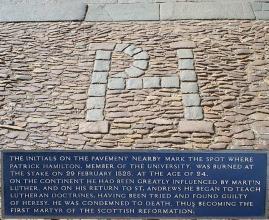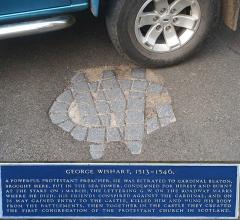You are here
NB page 6 bottom
Along with the growth of the nation state, the Christian church was becoming more organised. Monasteries, originally collectives of hermits, were established by the early Celtic chirch on remote islands, as if to emphasise their other-worldy and spiritual role. As the years went by, Lindisfarne became one of the main centres of European culture with links to the courts of King Alfred in Wessex and the Emperer Charlemagne in Aachen. Unfortunately, Lindisfarne bacame an accessible target for Viking raiders. The hand-wrought Linisfarne Gospels survived the attacks until the late 9th century when the now-pricelass manuscripts were nearly lost at sea by monks fleeing another "smash and grab". The Vikings did not seem to place much value on books.
But monasteries grew in size and wealth, and became important centres (sometimes the only centres) of literacy and learning. In turn this would lead to the establishment of universities: St Andrews University was given its charter in 1410 as a school attached to the Augustinian Priory. It was lucky that this was done, because the Cathedral and the rest of the church establishment was stripped out in 1559 during the Reformation.
The Reformation in England had started earlier, in 1536, precipitated by Henry the Eight's argument with the Pope over his divorce. For hundreds of years “church and state” had been a valuable counter-balance to absolute power. But now the monasteries were seen to be threatening the state, and the men of the church were widely seen, particularly by poor people, as bloated money-grabbers. Animosity was stirred by protestants such as John Knox. In St Andrews you can see the pavement memorials to protestant “martyrs” with mosaics now showing where their blood soaked into the cobbles. In the Dark Ages, people were fighting and killing each other over land. Now, in a worrying development, they were beginning to fight over ideas.
Click to read the plaque for the Patrick Hamilton memorial.JPG
Click to read the plaque for the George Wishart memorial.JPG

